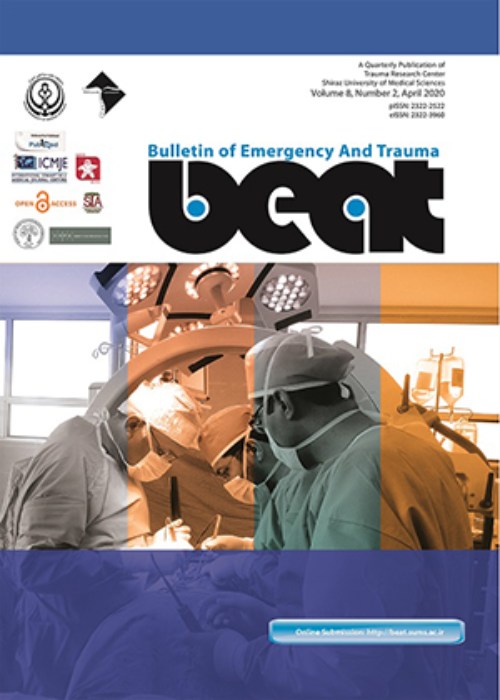High Risk Criteria in Level 2 May Provide a Source of Disagreement in Emergency Severity Index
Author(s):
Article Type:
Research/Original Article (دارای رتبه معتبر)
Abstract:
Dear Editor,
With great interest we have read the outstanding publication in the recent Bulletin of Emergency and Trauma issue by Ghafarypour-Jahrom et al. entitled “Validity and Reliability of the Emergency Severity Index and Australasian Triage System in Pediatric Emergency Care of Mofid Children’s Hospital in Iran” [1]. We bring your attention to the
With great interest we have read the outstanding publication in the recent Bulletin of Emergency and Trauma issue by Ghafarypour-Jahrom et al. entitled “Validity and Reliability of the Emergency Severity Index and Australasian Triage System in Pediatric Emergency Care of Mofid Children’s Hospital in Iran” [1]. We bring your attention to the
results
concerning the reliability of Emergency Severity Index (ESI) in the mentioned study that may provide a new understanding to lead clinical practice in emergency department (ED). The study used Cohen kappa values to report inter-rater reliability of Level 1 to 5 are 0.833, 0.777, 0.520, 0.850 and 0.883. Thereliability coefficient for level 4, 5 and 1 is almost perfect (> 0.80) which is reported in other literature too [2]. The reliability coefficient for level 2 and 3 is substantial and moderate respectively, implying that the agreement between raters suffers from discrepancy. This issue is even more remarkable while bearing in mind that a large number of patients in the ED belong to these categories. Besides, these patients have strong potential to get into critically ill condition. Therefore, it is vital to address this flaw in the literature. One of the criteria in ESI level 2 is “high-risk patients”. Nurses must perceive high-risk condition in patients based on their knowledge and expertise. “high-risk patients” in ESI level II is a broad and general concept and to some extent ambiguous which is not enough clear to identify high-risk patients sufficiently and prevent misclassification. Tanabe et al. defined level II patients as individuals who are more stable than level I and they indicated critically ill patients’ triage criteria needs further revisions [3]. This ambiguity congests a considerable amount of patients in level II if nurses are going to keep undertriage rate low. In addition, it may turn to a great source of conflict between nurses and physicians due to the fact that they may interpret high-risk condition differently. The reliability coefficient of 0.777 clearly supports this hypothesis. The reliability coefficient of 0.520 may indicate there is low agreement between the raters regarding resources which is necessary to fulfill emergency care for patients. Patient influx in ESI level II causes other parts of the ED remain unused. This issue could not be tolerated in the ED because triage nurses wants to consume all ED resources as much as possible conscientiously and reduces overcrowding. This issue deterioratedlonger practice of ESI in ED. This discrepancy deserves to be considered in further study. Conflicts of Interest: None declared. Language:
English
Published:
Bulletin of Emergency And Trauma, Volume:7 Issue: 1, jan 2019
Pages:
90 to 91
magiran.com/p1930716
دانلود و مطالعه متن این مقاله با یکی از روشهای زیر امکان پذیر است:
اشتراک شخصی
با عضویت و پرداخت آنلاین حق اشتراک یکساله به مبلغ 1,390,000ريال میتوانید 70 عنوان مطلب دانلود کنید!
اشتراک سازمانی
به کتابخانه دانشگاه یا محل کار خود پیشنهاد کنید تا اشتراک سازمانی این پایگاه را برای دسترسی نامحدود همه کاربران به متن مطالب تهیه نمایند!
توجه!
- حق عضویت دریافتی صرف حمایت از نشریات عضو و نگهداری، تکمیل و توسعه مگیران میشود.
- پرداخت حق اشتراک و دانلود مقالات اجازه بازنشر آن در سایر رسانههای چاپی و دیجیتال را به کاربر نمیدهد.
In order to view content subscription is required
Personal subscription
Subscribe magiran.com for 70 € euros via PayPal and download 70 articles during a year.
Organization subscription
Please contact us to subscribe your university or library for unlimited access!


